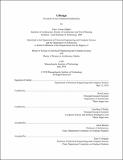| dc.contributor.advisor | Kent Larson and Una-May O'Reilly. | en_US |
| dc.contributor.author | Corem, Yaniv | en_US |
| dc.contributor.other | Massachusetts Institute of Technology. Deptartment of Architecture. | en_US |
| dc.date.accessioned | 2012-02-24T16:28:42Z | |
| dc.date.available | 2012-02-24T16:28:42Z | |
| dc.date.copyright | 2010 | en_US |
| dc.date.issued | 2010 | en_US |
| dc.identifier.uri | http://hdl.handle.net/1721.1/69190 | |
| dc.description | Thesis (S.M.)--Massachusetts Institute of Technology, Dept. of Electrical Engineering and Computer Science; and, (S.M.)--Massachusetts Institute of Technology, Dept. of Architecture, 2010. | en_US |
| dc.description | Includes bibliographical references. | en_US |
| dc.description.abstract | As more companies encourage users to participate in the design of personalized products through online configuration tools, a new kind of user-centered business model emerges. One of the outcomes of this transformation, is the restructuring of a company's products - from a one-size-fits-all to a kit-of-parts - allowing customers to mix-n-match. A similar process is taking place in architectural design, as more research projects and a few commercial applications employ mass-customization techniques to allow users to design and build their own living solutions. In this thesis, I propose a framework for user-centered architecture, called UDesign, and describe its implementation as a web application that allows users to design their own custom apartment. UDesign includes a sample one-bedroom apartment which users can customize through a kit-of-parts approach, i.e., a catalog of rooms (called assemblies), that can be combined to create a complete floor plan solution. While available configuration tools in architecture require the user to think like an expert, e.g., integrate form and function, UDesign takes a novel approach by deploying a suite of machine learning algorithms coupled with data from Facebook to model users' design preferences and match them with design solutions. Users can take advantage of these recommendations as their design starting point and continue to explore other alternatives by dragging and dropping rooms from the catalog on to the sample floor plan. As users explore design solutions, UDesign updates its recommendations to guide users through the design space and help them find solutions that best fit their needs. Finally, UDesign's integration with Facebook, allows users to share their designs, making UDesign part of their social network. | en_US |
| dc.description.statementofresponsibility | by Yaniv Corem (Ophir). | en_US |
| dc.format.extent | 101 p. | en_US |
| dc.language.iso | eng | en_US |
| dc.publisher | Massachusetts Institute of Technology | en_US |
| dc.rights | M.I.T. theses are protected by
copyright. They may be viewed from this source for any purpose, but
reproduction or distribution in any format is prohibited without written
permission. See provided URL for inquiries about permission. | en_US |
| dc.rights.uri | http://dspace.mit.edu/handle/1721.1/7582 | en_US |
| dc.subject | Electrical Engineering and Computer Science. | en_US |
| dc.subject | Architecture. | en_US |
| dc.title | UDesign : toward a user-centered architecture | en_US |
| dc.title.alternative | U Design | en_US |
| dc.title.alternative | Toward a user-centered architecture | en_US |
| dc.type | Thesis | en_US |
| dc.description.degree | S.M. | en_US |
| dc.contributor.department | Massachusetts Institute of Technology. Department of Architecture | |
| dc.contributor.department | Massachusetts Institute of Technology. Department of Electrical Engineering and Computer Science | |
| dc.identifier.oclc | 681906106 | en_US |

